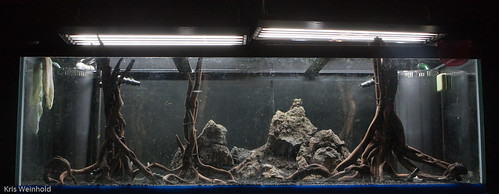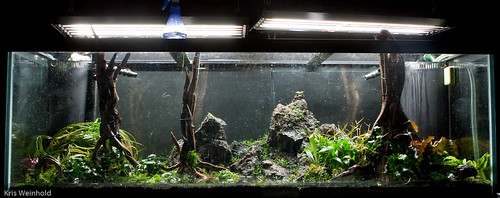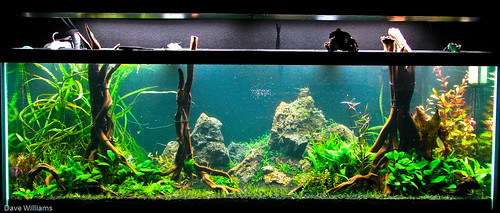Rescaping By Commitee
January 2nd, 2009Earlier in the week, one of our fellow GWAPA members, Dave Williams, invited a few people over to rescape his large 180G aquarium. With a tank this large, a little bit of help to plant can save a huge amount of time. By the time we arrived, Dave had done all of the prep work required, so we could start directly with the hardscape. He already had a vision in his head about the final aquascape, which was to bundle branches of wood together to form “trees,” and hopefully provide enough perspective with plants to have the effect of standing in the forest, with a mountain off in the background.
So, we got started by placing the trees in the tank, and then using several pieces of porous mossy rock to build up our mountain. After we did this, we realized that the mountain looked a little bit out of place, being the only rock in the tank.
So, we added a complementary mountain to the left of it. After several opinions were tossed around, we all decided that we didn’t like the separate mountain ranges, and would rather put a smaller peak in part of a larger mountain range. We were also trying to envision which pieces of the background would end up visible once the tank was planted. Ultimately, we ended up with what you see below.
Now, it was time to begin planting the tank. We added just enough water to allow for the plants to stick, and went to town. In the mountain itself, we wedged Cryptocoryne parva into any crack we could. The foreground consisted of hairgrass and a dwarf Lilaeopsis species. Anubias, Cryptocoryne crispatula var. ‘Balansae’, Cryptocoryne walkeri, Pogostemon helferi, among others made it into the tank.
Now it was time to fill the tank with water. As you can imagine, it takes quite awhile to fill a tank with 180 gallons of water slowly enough not to disturb the plants. Dave sent a picture of how the tank looks with the water in it.
As you can tell, plenty of growing needs to happen to really fill in a tank this size, but I’m very interested to see how this aquascape shapes up once it reaches maturity. I also recommend scaping with other people. It’s great to hear instant feedback on your original hardscape and plant selection ideas, so that you can make any minor adjustments before you finish.





January 2nd, 2009 at 12:05 pm
Wow, that looks incredible. Excellent job.
What kind of sticks and plants did you use?
January 2nd, 2009 at 12:25 pm
Salty, the wood is manzanita. The plants I recall are listed in the post. Thanks for your comment!
January 2nd, 2009 at 12:27 pm
That is a great scape. I don’t think I’ve developed such visions for tanks. I don’t have the patience. I just want to dump things into the tank and be done with it. Grow, damn you! Grow!
January 2nd, 2009 at 12:38 pm
That is gonna be so good. I wish I could put some of the wood etc. above the waterline, it works really well.
January 2nd, 2009 at 3:38 pm
My pleco would love to plow through all that beautiful work!
January 2nd, 2009 at 5:07 pm
Great collaborative effort!
January 2nd, 2009 at 5:55 pm
so wait, you didn’t add all the water at once correct? how often did you fill it up?
January 2nd, 2009 at 7:39 pm
Jerry, that’s correct. At first, you just fill it up with water to the substrate, which makes the substrate damp enough to plant in. Then, you do all of your planting, using a spray bottle to keep the plants from drying out. Only after you’re completely done do you fill up the tank. The key benefit to doing it this way is that you don’t uproot the fine particles into the water column when planting all of the plants. So, in theory, when you fill it up, the tank should be relatively clear. Plus, it’s very easy to see where you’re planting without having to look through the front of the tank.
January 3rd, 2009 at 12:23 am
Guitarfish: did the plants come from a reputable aquarium store? I am asking because I know the quality of the plant depends on a lot of things; especially if it wants to grow quickly and remain pest free.
Also, did you use anything other than porous rock in your substrate?
Awesome job on the tank! Looks like a lot of hard work. It would be idle to see some picture a few weeks later!
January 3rd, 2009 at 11:01 am
Nate, I believe Dave got all of the plants from his own tanks, or from other hobbyist. All were in excellent shape. The only rock we used in his tank was the porous mossy rock, and I agree that I’d like a photo update after a little while — I’ll have to bug Dave about that. 😉
January 3rd, 2009 at 11:58 am
Tank is doing pretty well so far, knock on wood. Very little melting. Lost osme Parva, and the Balansae may still melt. Other than that, things are lookin’ okay!
Plants, from left to right (some of them you cannot see yet in the pics)
Limnophila sp.
Crypt Balansae
Crypt Spiralis
Dwarf spotted Radican sword (front left)
Echinodorus Vesuvius
Anubias Nana
Limnophila sp. ‘mini’
Arthraxon sp. Malaysia
Eleocharis sp.
Crypt Willissii
Anubias nana petite
Rotala mini type 1
Eleocharis Parvula
Crypt Parva
Ammannia Bonsai
Purple Bamboo
Lillaeopsis sp.
Anubias nana Narrow
Java fern Trident
Hemigraphis Traian
Alternanthera sp.
Nate – I buy very few plants from stores anymore. I buy from fellow hobbyists almost exclusively. Most of these plants were growing in the tank previous to the rescape – a handful of the plants in here were bought from a hobbyist in NJ for this scape, and Kris generously donated a couple as well.
January 3rd, 2009 at 12:47 pm
Forgot downoi, pogogstemon Helferi.
List is too long! Me and my collectoritis… 😉
January 4th, 2009 at 3:32 am
Wow! Truly a winner!
January 4th, 2009 at 6:58 pm
Dave,
Do you use any additives in the tank to sustain such a prolific selection of aquatic plants?
I am curious because I mixed 1/4 strength nitrogen and kelp fertilizer which I added to my 55 fresh. The nutes came from a hydroponic store.
I saw really fast growth rates after only two weeks of use. than I stopped because I could already see that my plecostomus couldn’t keep up with nuisance algae.
January 5th, 2009 at 9:22 am
I run a different style of system. This is a mineralized soil substrate tank – I think Kris has mentioned it a time or two here.
The only thing I add to the water column is tiny trace amounts of potassium, the plants feed from the substrate in this kind of a system.
January 5th, 2009 at 9:48 am
Nate, in addition, for tanks that do require fertilization, finding balance is the way to avoid the algae that you found in your experience. It’s likely that you added nitrogen out of proportion to potassium, phosphorous, and traces, thus having excess fertilizers in the water that your plants couldn’t use, but algae could. For dosing, I recommend people start with a commercial line like Seachem’s product line, and then once you understand the basis behind dosing, you can switch to dry fertilizers for NPK to save money.
January 7th, 2009 at 5:42 pm
How do the parva planted on the rock mountains have access to the substrate since they are growing on the “mountain”? I keep worrying about doing the mineralized soil substrate and then having plants out of the substrate suffer for it. Java fern may not care, but I worry about having to stuff the substrate into cracks and what not as well to give other plants access.
January 7th, 2009 at 5:55 pm
Good question Corey. Dave cheated a little bit and put a layer of aquasoil in the mountain for those plants. I’m looking forward to seeing how that works out long term.
August 28th, 2013 at 12:56 pm
Is there any possibility of getting an updated photo showing this tank at maturity?
August 28th, 2013 at 1:01 pm
Sure, it won 3rd place in it’s category in the 2009 AAC Acuavida contest:
http://www.aac.acuavida.com/gallery/AAC_2009/grandes_acuarios/David+Williams/180g_202009_20final.jpg.html